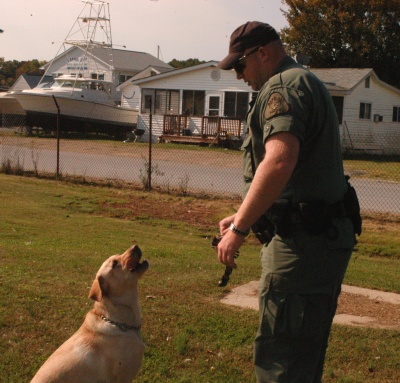
Maryland Department of Natural Resources Police Officer Tim Pheabus gets his dog, 3-year-old Ruddy, ready to work with a snap collar, the sound of which signifies to Ruddy that it is time to track. Ruddy tracked Pheabus' cell phone, a credit card and a single shotgun shell in the grass near Breezy Point Marina in Calvert County on Oct. 13. (Capital News Service Photo by Aleksandra Robinson)
By ALEKSANDRA ROBINSON
LUSBY (Oct. 16, 2009)—The shining black Labrador retriever's tail snapped back and forth like a flag in the wind as he jumped happily in the tall grass—Blu completed his mission and gleefully attacked a black Kong toy in a victory dance.
"Good boy!" said Blu's handler, Department of Natural Resources Police Officer Curt Dieterle, retrieving the unloaded gun that had been pitched into the tall grass minutes earlier while 5-year-old Blu was still in the truck.
Dieterle and Blu were participating in quarterly training for the NRP K-9 unit Oct. 1 near Calvert Cliffs State Park in Calvert County. The NRP is responsible for rural and maritime search and rescue, and enforces conservation, boating and criminal laws throughout the state. The NRP polices state parks and state forests as well.
Every quarter, Dieterle said, the unit tries to set up training for the dogs, in addition to the daily training K-9 officers do with their dogs and the one day a month the officer spends training the dog.
"You're always doing something with this dog," Dieterle said. "We spend more time with our dogs than our spouses. ... You get the dog you deserve."
Most of the NRP dogs come from shelters and pounds—all of them come free to the department. Blu was found in a pound by a Fish and Wildlife officer in Florida, said Sgt. Lisa Nyland, officer in charge of the K-9 unit.
When they're on the lookout for dogs, Nyland said, officers spend a good deal of time in dog pounds and shelters testing dogs for high prey and hunt drives as well as a strong instinct to retrieve. Dogs like Blu are then given 400 hours of initial training before they are used in the field.
"The qualities that make a good working dog make a poor house pet and that's why they end up at the pound," said Nyland, who, like all NRP K-9 officers, lives with her dogs. "They have so much energy and no way to channel it."
Because dogs are only rewarded with play time when they are successful, handler and dog will do 10 practice missions for every real-world mission, Dieterle said. Each practice mission is successful for the dog. If a dog fails too frequently, Dieterle said, he won't track.
For the NRP, dogs are used for different types of searching and finding. Blu, for instance, is trained to do three things: track (as when a person is missing), article search (to find a manmade item, like a gun, in a natural setting) and detect (as with drug dogs; Blu detects wildlife).
When two men fishing without licenses in a closed trout stream ran from an officer, Blu, for example, was called in to track.
"I found their tracks along the stream and deployed Blu, and after following across a stream, tracked up a hollow, then went up over top of a hill down to another stream, crossed that stream, went to the top of another mountain and we got to a flat and there was an old logging road there ... this trail led out to a large grass field ... crossed old Route 40, made a left, crossed over the side of the road," he said.
Blu led him straight to the back door of the man's house, despite the fact that he had gotten onto a four-wheeler midway through his flight.
"It was probably about a 1.5 mile track," Dieterle said.
The man was charged with fishing in a closed stream and fishing without a license—crimes that add up to about $300 in fines.
Sgt. Kent Gregory, a K-9 handler from the Calvert County Sheriff's Department, came out to watch the NRP dogs work and brought along his German shepherd, Biz. The shepherds from the sheriff's office, like most police dogs, are trained for patrol—their aggression is molded and the dogs are not all friendly, Gregory said—whereas the NRP Labs are trained only to find. NRP dogs frequently work without leashes and in close quarters with people, said Nyland, so aggressive dogs are taken out of the program.
NRP dogs are used more frequently in cases where a hiker or hunter is missing or in situations where someone has been hunting or fishing illegally and needs to be found. Some dogs are used to find cadavers on land or in the water in cases like drowning accidents.
Art Windemuth, public information officer for NRP, said the decision to call in the dogs—there are seven dogs with the NRP—is usually made by the supervisor of an officer who responds to a call.
"A decision has to be made about how quickly a K-9 officer can get down, the severity of the incident, the likelihood of apprehending that individual or locating that individual," Windemuth said.
Officers must determine, "What are the effects of waiting and delaying that search and waiting for the K-9 to get there? ... (The supervisor) has to make a decision about whether you want to wait or whether you want to launch a search and he has to take all of those factors into account."
All officers are introduced to working with the dogs during training, Windemuth said, though according to Dieterle, that doesn't always mean the dogs are called soon enough.
"There's times when it's no win," Dieterle said. "If it was a missing person, there's times when volunteers will get in and contaminate the scene."
Dieterle said it's important not to get discouraged when a search isn't successful.
"Whatever I'm feeling goes right down the lead to your dog," he said. "It's a coordinated effort."
Capital News Service contributed to this report.


